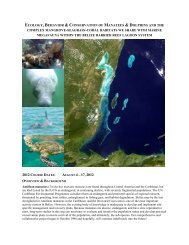Tribute to Dr. Akoi Kouadio - Sirenian International
Tribute to Dr. Akoi Kouadio - Sirenian International
Tribute to Dr. Akoi Kouadio - Sirenian International
You also want an ePaper? Increase the reach of your titles
YUMPU automatically turns print PDFs into web optimized ePapers that Google loves.
protected areas are new with respect <strong>to</strong> their formation. The actions <strong>to</strong>wards implementation of management plan for these protected<br />
areas are underway and their success in protecting dugongs and their habitats depend on appropriate moni<strong>to</strong>ring. The presentation<br />
intends <strong>to</strong> cover dugong research findings from the region and document strength, weaknesses and opportunities of the protected areas<br />
<strong>to</strong> protect dugongs and their habitats.<br />
Manatees and marine protected areas in the island of Hispaniola. Haydée M. Domínguez Tejo, Centro de Investigaciones de<br />
Biología Marina, Universidad Autónoma de San<strong>to</strong> Domingo (CIBIMA-UASD). San<strong>to</strong> Domingo, Dominican Republic<br />
In the Dominican Republic, by Law 202-04, the national system of protected areas (SINAP) is currently comprised of 86<br />
units, of which 29 can be considered coastal marine protected areas (CMPA´s). Manatees are protected by national laws, since 1938,<br />
and by international agreements CITES, CBD and the Cartagena Convention. The general distribution of manatees in the country is<br />
known. Furthermore, manatee presence has been recently confirmed in at least nine of the CMPA´s located all around the country by<br />
means of: (a) direct observations during land, boat and aerial surveys, as well as carcass recoveries; and (b) reliable sighting reports<br />
from land, water and during commercial flights, all dating from 2004 until present. In addition, site specific studies have been<br />
conducted in the two marine mammal sanctuaries by CIBIMA-UASD from 2007-2008, and in CMPA´s around Samana Bay in 2008-<br />
2009 by Wildlife Trust.<br />
In Haiti the current status of manatees is unknown, but important progress is underway. In 2007, there were manatee<br />
sightings in the Port-au-Prince bay area, along the seagrass beds north of Arcahaie. There are no national laws that specifically protect<br />
manatees in the country. However, recent progress has been made <strong>to</strong>wards establishing Haiti’s first MPA; a presidential decree has<br />
been prepared and is currently under evaluation. The proposed protected area includes the location of the latest manatee sightings.<br />
Information regarding the current situation in Haiti was kindly provided by Jean W. Weiner, Direc<strong>to</strong>r of the marine conservation NGO<br />
Fondation pour la Protection de la Biodiversité Marine (FoProBim).<br />
Spatial management of indigenous hunting: dugong case study. Jillian Grayson, Alana Grech, Helene Marsh, and Mark Hamann;<br />
School of Earth and Environmental Sciences, James Cook University, Townsville, Qld 4811, Australia<br />
Torres Strait has the largest population of dugongs in the world. This population has persisted despite substantial hunting in<br />
the past 300 years of a 4000 year hunting period. We proposed that this situation was possible if a substantial proportion of the<br />
dugong population occurred in areas that have never been hunted. Our study used information from Indigenous hunters <strong>to</strong> compare<br />
the spatial distribution of dugong hunting with a spatial model of dugong distribution in the theoretical context of source-sink<br />
dynamics. Our study revealed that dugong hunting mainly occurs in waters close <strong>to</strong> inhabited islands or on reef <strong>to</strong>ps whereas most of<br />
the high density dugong habitat identified by aerial surveys occurs outside the main hunting areas. Hence these non-hunted or lightly<br />
hunted areas with a high density of dugongs could serve as a source for the population and the main hunted areas as a sink. Dugongs<br />
are known <strong>to</strong> undertake individualistic large-scale movements which would enable them <strong>to</strong> disperse between the main hunting areas<br />
and non-hunted or lightly hunted refuges. Therefore, source-sink dynamics may help explain the sustained harvest of dugongs over<br />
the previous 300 years but they alone may not be sufficient <strong>to</strong> conserve this population. However, we show that spatial closures<br />
should afford considerable protection <strong>to</strong> dugongs and their habitats in Torres Strait while more comprehensive community-based<br />
approaches <strong>to</strong> regulate legal harvests are negotiated and implemented.<br />
An overview of the protection afforded <strong>to</strong> dugongs from MPAs in Australia and the Pacific. Alana Grech 1,2 and Helene Marsh 1,2 ;<br />
1 School of Earth and Environmental Sciences, James Cook University, Townsville, QLD 4811, Australia; 2 Reef and Rainforest<br />
Research Centre, P.O. Box 7772, Townsville, QLD 4810, Australia<br />
Dugongs inhabit the shallow, protected tropical waters of the Indo-Pacific. Their range spans at least 37 countries and an<br />
estimated 140,000 km of coastline. Dugongs have a high biodiversity value as the only strictly herbivorous marine mammal and the<br />
only member of the family Dugongidae, and are listed as vulnerable <strong>to</strong> extinction by the IUCN, the World Conservation Union (IUCN<br />
2006). Throughout their range dugongs are threatened by anthropogenic activities including hunting and bycatch. Their coastal<br />
seagrass habitats are threatened by multiple anthropogenic activities, including activities that occur in adjacent land catchments.<br />
Managing the anthropogenic threats <strong>to</strong> dugongs with spatial <strong>to</strong>ols (including Marine Protected Areas) is challenged by: the dugong’s<br />
extensive range and their tendency <strong>to</strong> undertake individualistic and large scale movements; and the paucity of information on the<br />
magnitude and distribution of their anthropogenic threats. In this seminar we summarize the protection currently afforded <strong>to</strong> dugongs<br />
from Marine Protected Areas in Australia and the Pacific, and explore the benefits and weaknesses of a spatial approach <strong>to</strong> dugong<br />
management. We use examples taken from developing and more developed regions including the Great Barrier Reef World Heritage<br />
Area and Torres Strait <strong>to</strong> illustrate our argument.<br />
Sirenews No. 52 15 Oc<strong>to</strong>ber 2009













